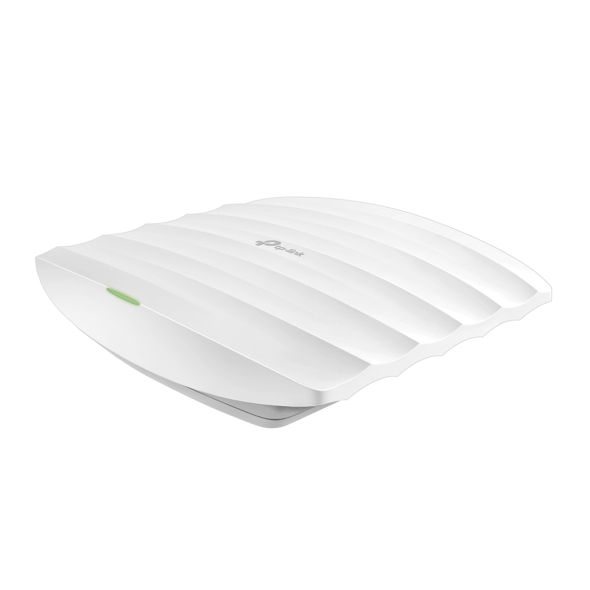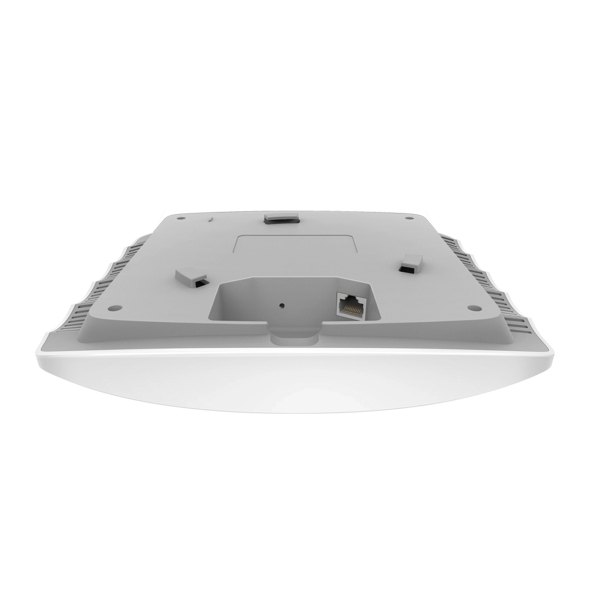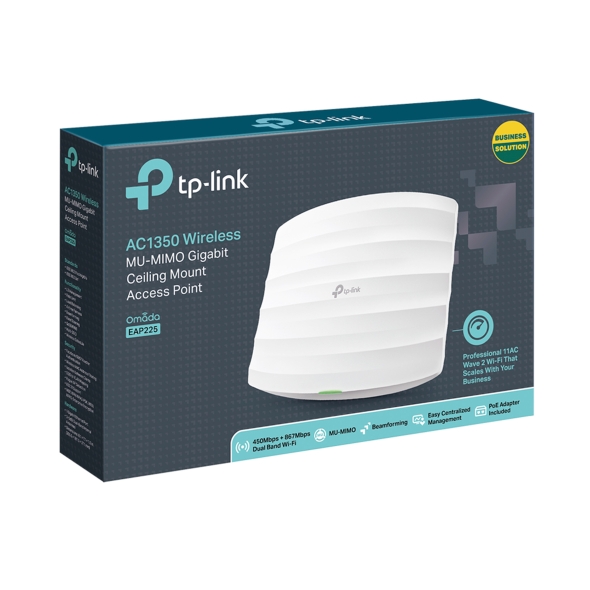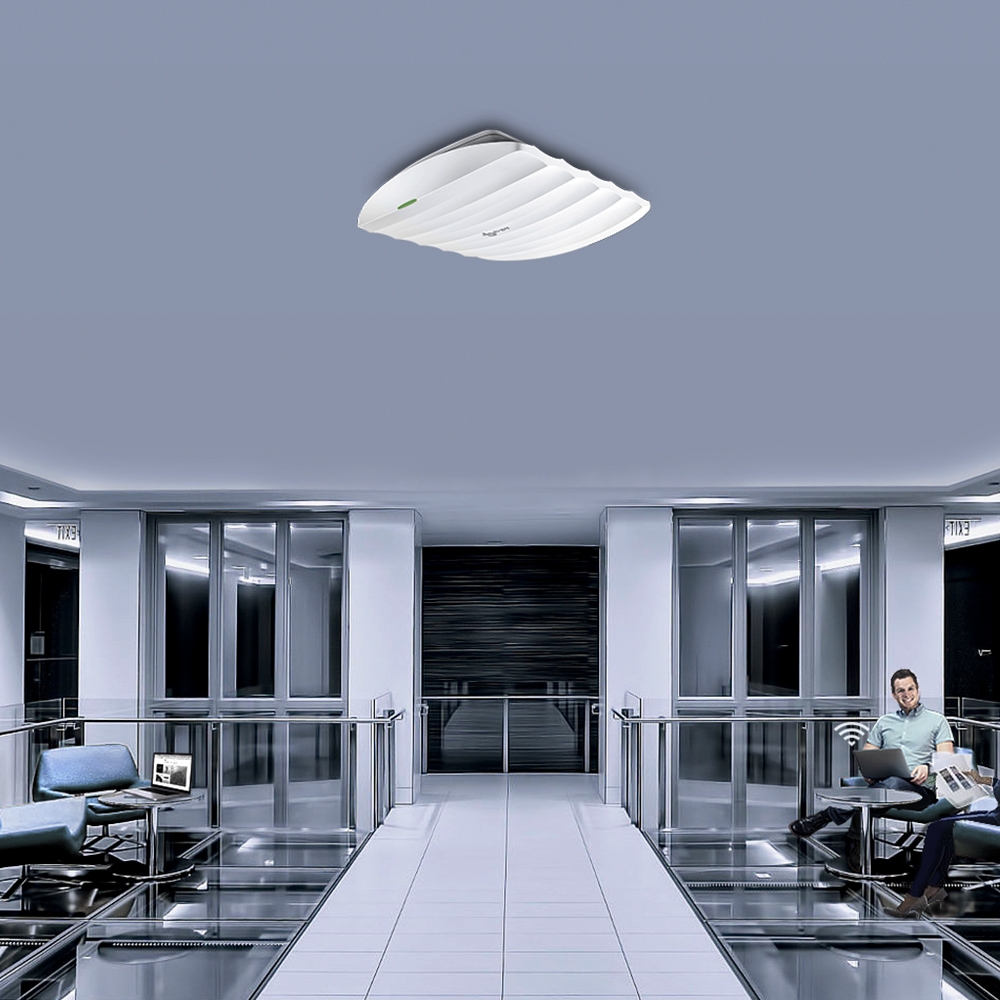AC1350 Wireless Dual Band Gigabit Ceiling Mount Access Point
- Fast Dual-Band Wi-Fi: Simultaneous 450 Mbps on 2.4 GHz△ and 867 Mbps on 5 GHz totals 1317 Mbps Wi-Fi speeds.†
- Integrated into Omada SDN: Zero-Touch Provisioning (ZTP)‡, Centralised Cloud Management, and Intelligent Monitoring.
- Centralised Management: Cloud access and Omada app for ultra convenience and easy management.
- Seamless Roaming: Even video streams and voice calls are unaffected as users move between locations.*
- PoE Support: Support both standard 802.3af and Passive PoE (PoE adapter included)△ for flexible installations.
- Secure Guest Network: Along with multiple authentication options (SMS/Voucher, etc.) and abundant wireless security technologies.
- Advanced Wireless Tech: Optimise network performance with MU-MIMO, Band Steering, Airtime Fairness and Beamforming technologies.△
An Affordable Business-Class
802.11ac MU-MIMO Wi-Fi Solution

Superior Wi-Fi Speeds with MU-MIMO Technology
Outfitted with the latest 802.11ac Wave 2 MU-MIMO technology, the EAP225 easily delivers dual-band Wi-Fi speeds of up to 1350 Mbps to multiple devices at the same time.†
- Traditional SU-MIMO
(Single-User MIMO) AP - sends data to one device at a time that causes more latency
- MU-MIMO
(Multi-User MIMO) EAP - simultaneously sends data to multiple devices for faster speed
Omada SDN—Smarter Cloud Solution for Business Networking
Omada Software Defined Networking (SDN) platform integrates network devices including access points, switches and gateways, guaranteeing powerful business network with higher efficiency, higher security, and higher reliability.
Cloud-Based Controller
Hassle-Free Centralised Cloud Management:
100% centralised cloud management of whole network from different sites—all controlled from a single interface anywhere, anytime.
Secure Guest Network with and SMS Authentication
The captive portal helps maintain only authorised guests to use the network, presenting devices with a convenient, user-friendly authentication method to grant Wi-Fi access. The addition of SMS authentication simplifies the captive portal even further to simplify connectivity and boost your business.*
Multiple PoE Options for Easy Installation
EAP225 supports both 802.3af PoE and Passive PoE power supply, which can be either powered by a PoE switch or the provided PoE adapter, making deployment effortless and flexible.
Gigabit Ethernet
Port 802.3af PoE/
24V Passive PoE
Easy Management with the Omada App
Follow configuration instructions on the free Omada app to get set up in minutes. Omada lets you configure settings, monitor the network status and manage clients, all from the convenience of a smartphone or tablet.
Related Cases
-
Shuraa Facilities Management LLC
Shuraa Facilities Management LLC Chooses TP-link for Wireless Service Deployments
Shuraa Facilities Management LLC
Shuraa Facilities Management LLC Chooses TP-link for Wireless Service Deployments
“The hotel has overcome some of its Wi-Fi internet connectivity for guests following the implementation of TP-Link’s solutions. In addition, it has been able to provide connectivity in more than 100 guest apartments without compromising of guest comfort and experience.”
| HARDWARE FEATURES | |
|---|---|
| Interface | Gigabit Ethernet (RJ-45) Port×1 (Support IEEE802.3af PoE and Passive PoE) |
| Physical Security Lock | Yes |
| Button | Reset |
| Power Supply | 802.3af PoE /24V Passive PoE |
| Max. Power Consumption | 12.6 W |
| Dimensions ( W x D x H ) | 8.1 × 7.1 × 1.5 in (205.5 × 181.5 × 37.1 mm) |
| Antenna | 3 Internal Omni• 2.4 GHz: 4 dBi• 5 GHz: 5 dBi |
| Mounting | Ceiling /Wall Mounting (Kits included) |
| WIRELESS FEATURES | |
|---|---|
| Wireless Standards | IEEE 802.11ac/n/g/b/a |
| Frequency | 2.4 GHz and 5 GHz |
| Signal Rate | • 5 GHz:Up to 867 Mbps• 2.4 GHz:Up to 450 Mbps |
| Wireless Functions | • Multiple SSIDs (Up to 16 SSIDs, 8 for each band)• Enable/Disable Wireless Radio• Automatic Channel Assignment• Transmit Power Control (Adjust Transmit Power on dBm)• QoS(WMM)• Seamless Roaming*• Omada Mesh*• Band Steering• Load Balance• MU-MIMO• Airtime Fairness• Beamforming• Rate Limit• Reboot Schedule• Wireless Schedule• Wireless Statistics based on SSID/AP/Client |
| Wireless Security | • Captive Portal Authentication*• Access Control• Wireless Mac Address Filtering• Wireless Isolation Between Clients• SSID to VLAN Mapping• Rogue AP Detection• 802.1X Support |
| Transmission Power | • CE:≤20 dBm(2.4 GHz, EIRP)≤23 dBm(5 GHz, EIRP)• FCC:≤24 dBm(2.4 GHz)≤22 dBm(5 GHz) |
| Management Features | |
|---|---|
| Omada App | Yes |
| Centralized Management | • Omada Hardware Controller OC300• Omada Hardware Controller OC200• Omada Software Controller• Omada Cloud-Based Controller (Supported by EAP225 V3.0, V4.0 and above, and is not supported by EAP225 V3.20) |
| Cloud Access | Yes, through• OC300• OC200• Omada Software Controller• Omada Cloud-Based Controller (Supported by EAP225 V3.0, V4.0 and above, and is not supported by EAP225 V3.20) |
| Email Alerts | Yes |
| LED ON/OFF Control | Yes |
| Management MAC Access Control | Yes |
| SNMP | v1,v2c |
| System Logging Local/Remote Syslog | Local/Remote Syslog |
| SSH | Yes |
| Web-based Management | HTTP/HTTPS |
| L3 Management | Yes |
| Multi-site Management | Yes |
| Management VLAN | Yes |
| Zero-Touch Provisioning | Yes. Requiring the use of Omada Cloud-Based Controller (Supported by EAP225 V3.0, V4.0 and above, and is not supported by EAP225 V3.20) |
| OTHERS | |
|---|---|
| Certification | CE, FCC, RoHS |
| Package Content | • AC1350 Wireless MU-MIMO Gigabit Ceiling Mount Access Point EAP225• Passive PoE Adapter• Power Cord• Mounting Kits• Installation Guide |
| System Requirements | Microsoft Windows XP, Vista, Windows 7, Windows 8, Windows10, Windows11, Linux |
| Environment | • Operating Temperature: 0–40 ℃ (32–104 ℉)• Storage Temperature: -40–70 ℃ (-40–158 ℉)• Operating Humidity: 10–90% RH non-condensing• Storage Humidity: 5–90% RH non-condensing |
†Maximum wireless signal rates are the physical rates derived from IEEE Standard 802.11 specifications. Actual wireless data throughput and wireless coverage are not guaranteed and will vary as a result of 1) environmental factors, including building materials, physical objects, and obstacles, 2) network conditions, including local interference, volume and density of traffic, product location, network complexity, and network overhead, and 3) client limitations, including rated performance, location, connection, quality, and client condition.
‡Zero-Touch Provisioning requires the use of Omada Cloud-Based Controller. Note that EAP225 v3.20 doesn't support Omada Cloud-Based Controller. Please go to Omada Cloud-Based Controller Product List to find all the models supported by Omada Cloud-Based Controller.
*Omada Mesh, Seamless Roaming, Cloud Access, and Captive Portal require the use of Omada SDN controllers. Please go to Omada Mesh Product List to find all the models supported by Omada mesh technology, and refer to the User Guides of Omada SDN controllers for configuration methods.
△The functions of MU-MIMO, Airtime Fairness and Beamforming, specifications of 3 Internal Omni antenna, 450 Mbps on 2.4 GHz and Passive PoE are only supported by EAP225 v3 and above.



















